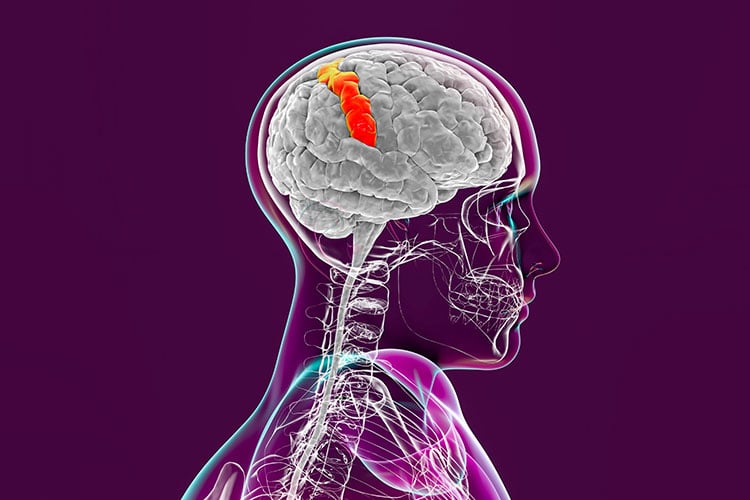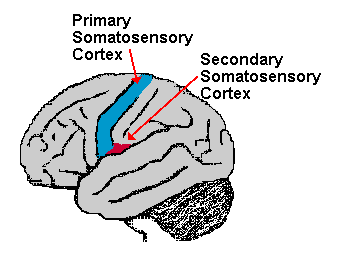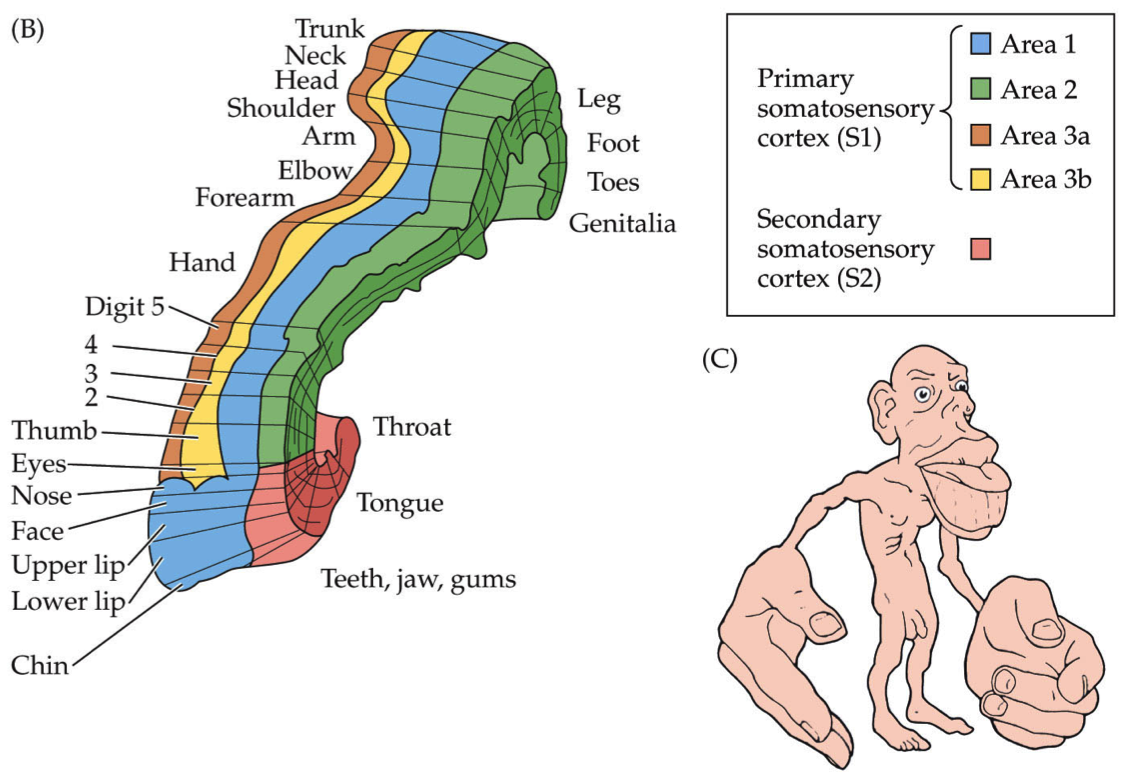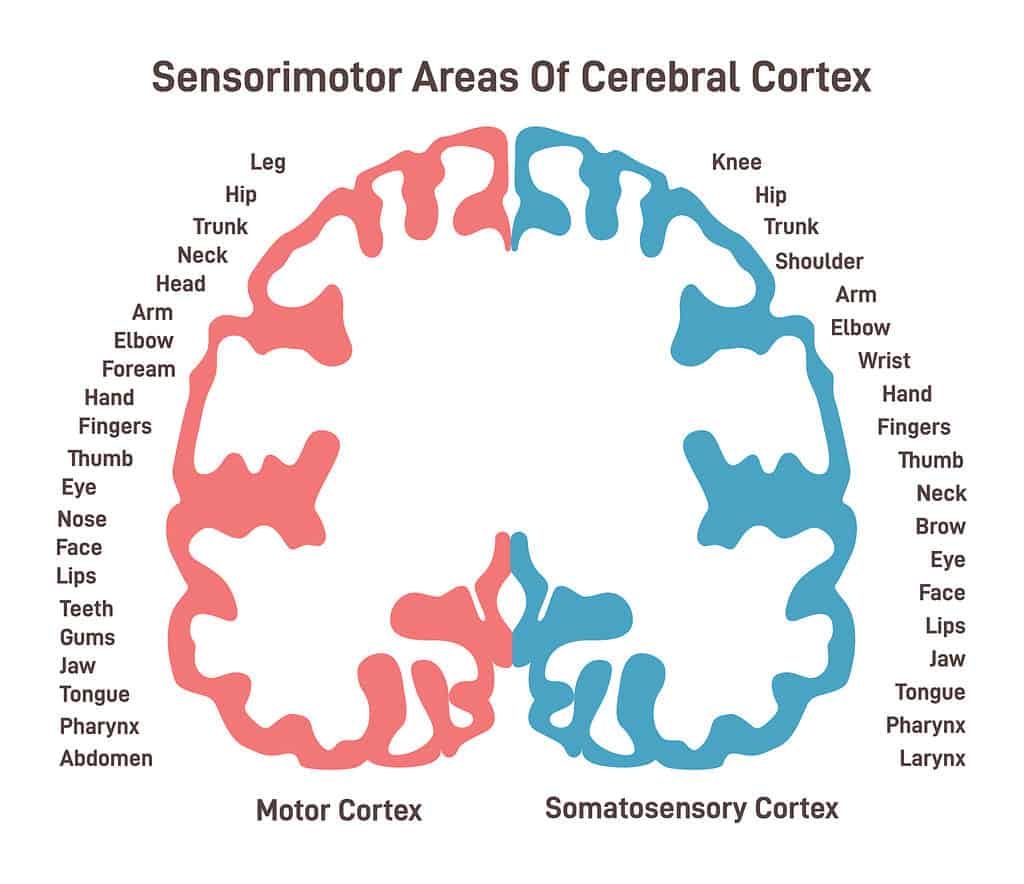On This Page:
The somatosensory cortex is a region of the brain located in the parietal lobe and lies behind the primary motor cortex of the frontal lobe. It is responsible for processing sensory information from the body.
The cortex interprets tactile stimuli, such as touch, temperature, pain, and proprioception (awareness of body position). Different areas of the somatosensory cortex correspond to specific body parts, creating a mapped representation of the body’s sensory surface.

The somatosensory cortex receives tactile information from the body, including sensations such as touch, pressure, temperature, and pain. This sensory information is then carried to the brain via neural pathways to the spinal cord, brainstem, and thalamus.
This information is then projected to the somatosensory cortex, which has numerous connections with other brain areas to process the sensory information.
The somatosensory cortex uses sensory information to initiate important movements that may be required to deal with particular situations.
Somatosensory Pathway
Somatosensory pathways are typically comprised of three neurons: primary, secondary, and tertiary.
The primary neurons are the sensory receptors within the periphery of the somatosensory cortex, which can detect various stimuli such as touch or temperature. The secondary neurons are located within the spinal cord and brainstem and act as a relay station.
Afferent pathways (which carry signals to the central nervous system) in the spinal cord and brainstem work by passing information from the periphery and the rest of the body to the brain. These will then terminate in either the thalamus or the cerebellum.
The tertiary neurons, located within the thalamus and cerebellum, will then project to the somatosensory cortex. This will then aid in forming a sensory homunculus, a representational map of the body.
Somatosensory Cortex Area Function
It comprises the primary somatosensory cortex and the secondary somatosensory cortex.


Primary Somatosensory Cortex
The primary somatosensory cortex, also referred to as S1, is found in a ridge of the cerebral cortex known as the postcentral gyrus.
Located just posterior of the central sulcus, a fissure that runs down the side of the cerebral cortex, the primary somatosensory cortex comprises of Brodmann’s areas 3a, 3b, 1, and 2.
The primary somatosensory cortex receives projections from nuclei of the thalamus of the brain.
These nuclei receive fibers from the contralateral half of the body, meaning the opposite side of the body from which the area is located in the brain.
Overall, the primary somatosensory cortex is responsible for the processing of sensations from the body.
These sensations are received through receptors located throughout the body that are responsible for detecting sensations such as touch, pain, temperature, and proprioception (the body’s ability to perceive its own position in space).
Brodmann’s area 3 is responsible for receiving most of the somatosensory input from the thalamus, with the initial processing of information occurring here.
Brodmann area 3b is responsible for processing the basics of touch sensations, whilst area 3a responds to information from proprioceptors (receptors responsible for proprioception). Area 3b is also connected to areas 1 and 2 which is where more complex processing takes place.
Area 1 specifically is important in sensing the texture of an object. Area 2, however, has a role in perceiving the shape and size of objects as well as being involved with proprioception.
An important function of the primary somatosensory cortex is the ability for it to locate where specific sensations arise in the body. This allows us to pinpoint the exact location of touch, pain, and pressure for instance.
This region is also responsible for being able to perceive pressure by judging the degrees of pressure put on the body. Another function of this area is that it can help us determine the weight of an object by looking at it.
This is useful so that we are able to determine if we are able to carry something, and to give a better idea of whether extra effort is required to carry it. Likewise, the primary somatosensory cortex can help us judge the shapes of objects with our eyes closed and be able to identify objects through touch.
For instance, you could hold a book in your hands and be able to identify the object with your eyes closed based on how this object feels. Similarly, this region would help us judge the texture of objects, which would be dependant on the movement of the fingers and hands over the surface of an object.
Therefore, you could run your fingers over the book and the pages within and know what this object was by the texture.
Secondary Somatosensory Cortex
Posterior to the primary somatosensory cortex lies the secondary somatosensory cortex. This region of the Parietal lobe seems to be serve as an association area for sensory input. It is involved with episodic memory, visuospatial processing, reflections upon self, and aspects of consciousness.
The secondary somatosensory cortex, also referred to as S2 is not as well understood as the primary somatosensory cortex, and it is believed that a lot of the fibers in this area come from the primary somatosensory area.
The secondary somatosensory cortex is located adjacent to the primary somatosensory cortex in the upper part of the lateral sulcus, a fissure in the cortex that separates the frontal and parietal lobes from the temporal lobes.
This region is believed to not only be connected to the primary somatosensory cortex but also receives direct projections from the thalamus.
The secondary somatosensory cortex is believed to be involved in tactile object recognition and memory. It is suggested that whilst the primary area receives peripheral sensory information, it requires the secondary area to store, process, and retain this information.
This area has been shown to contain many somatotopic representations of the body, which are complex and suggest multiple subregions of this area. S2 is also thought to represent the sensory discriminative aspects of pain.
Neuroimaging studies have found that bilateral activation within the secondary somatosensory cortex relates to the perceived intensity of the pain (Coghill, 2009).
Finally, the secondary somatosensory cortex connects to the hippocampus and the amygdala. This allows it to receive information from the environment and make decisions on how to deal with this information through using past experiences and how we feel about the information.
Homunculus Map
Within the somatosensory cortex, parts of the body are represented on a sensory homunculus map. This means that there are areas within the somatosensory cortex that are arranged such that a particular location receives information from a particular part of the body.

Thus, the surface area of the cortex dedicated to a part of the body correlates with the amount of sensory information from that area.
Some areas of the body are more sensitive than others and are therefore represented in the homunculus map in a distorted way, so those areas of the body take up a disproportionate amount of space.
For instance, the hands and the lips are very sensitive to sensations. So there is a large area of the somatosensory cortex dedicated to sensation in these areas.
In contrast, body parts such as the back are less sensitive to sensations and would therefore have a much smaller area represented in the cortex.
Typically, the medial portions of the sensory homunculus represent body parts such as the hips and, below, those less sensitive to sensation.
At the same time, the lateral sides have a larger surface area which would be where the areas for fingers, lips, eyes, and face would be, those which would be more sensitive to sensations.
Somatosensory Cortex Dysfunction
Damage to the somatosensory cortex can result in mostly mild deficits, and damage symptoms depend on which area was damaged.
Damage to this could result from lesions to one or more areas, sometimes due to a stroke. Another type of lesion is multiple sclerosis (MS) which results in loss of proprioception or exteroception (sensations from stimuli outside the body).
Below are descriptions of some of the symptoms that may be experienced as a result of damage:
Numbness
Damage to the somatosensory cortex can produce numbness or sometimes paraesthesia, which is a tingling sensation in certain parts of the body. Numbness can result due to damage in the cortex which then affects the receptors in the body for certain areas.
As more sensitive areas such as the hands and face have the most receptors and take up the largest amount of surface area on the cortex, these are most susceptible to numbness.
This numbness as a result of damage can also result in difficulties with being able to detect the temperature of something, which could be a safety issue if an individual is unable to recognize when a surface may be scolding hot, for instance.
Inability to Localize Sensations
Damage could result in individuals being unable to pinpoint where on their body a sensation has taken place. They can localize to an extent by identifying the general region a sensation occurred, such as stating the back or a certain leg.
This identification is possible due to other brain regions in the cerebral cortex being able to localize as well.
Similarly, someone with damage to this area would have difficulty being able to recognize things being traced onto their skin, such as being unable to identify what letter has been traced on a hand.
This inability is called tactile agnosia, and people with this condition may also have difficulties identifying objects by touch alone.
Therefore, if they close their eyes and are asked to identify an object, they may find it difficult to identify whether they are holding a book or a cup, as these may feel the same to them.
Inability to Judge Weight and Pressure
Another possible symptom of damage is the inability to judge the weight of objects. These individuals would not be able to identify whether an object was heavy or light after carrying it. Likewise, people with this damage would find difficulty in judging physical pressure.
These individuals may be able to know that pressure has been applied to their bodies but would not be able to identify the degree or severity of the pressure applied.
Phantom Limb Pain
It is relatively common for people who have had a limb amputated to experience sensations in their amputated limb. This is called phantom limb and can cause some pain to individuals suffering from it.
Studies have found that this pain shows correlations to changes in the primary somatosensory cortex, which is no longer receiving expected input from the amputated limb (Flor, 2003).
References
Coghill, R. R. (2009). Pain: Neuroimaging. Encyclopedia of Neuroscience, 409-414.
Flor, H. (2003). Remapping somatosensory cortex after injury. Advances in neurology, 93, 195-204.
Neuroscientifically Challenged. (2016, March 10). Know your brain: Primary somatosensory cortex . https://www.neuroscientificallychallenged.com/blog/know-your-brain-primary-somatosensory-cortex
Purves, D., Augustine, G., Fitzpatrick, D., Katz, L., LaMantia, A., McNamara, J., & Williams, S. (2001). Neuroscience 2nd edition. sunderland (ma) sinauer associates. Types of Eye Movements and Their Functions.
Raju, H., & Tadi, P. (2020). Neuroanatomy, Somatosensory Cortex. StatPearls [Internet].
The Human Memory. (2020, November, 25). Somatosensory Cortex . https://human-memory.net/somatosensory-cortex/

